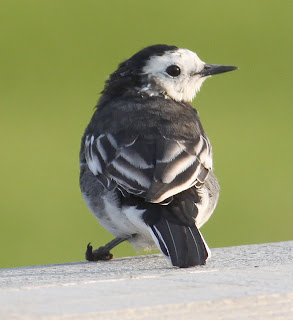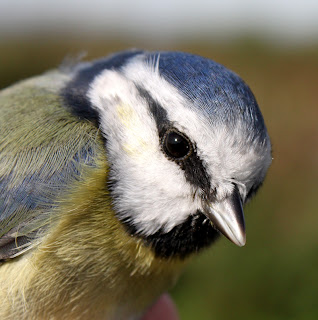The stiff westerly wind meant any ringing was definitely off the cards this morning, but I needed to top up the bird feeders at Out Rawcliffe so took a drive out there to do a spot of birding as well.
The Goldfinch haven’t taken much seed lately, mainly because there’s still plenty of natural food about, but today I disturbed 10 or 12 Goldfinches and a Lesser Redpoll from the 6 feeders before topping up with more than a litre of Nyger. Another 30 or more Goldfinches, 7 Linnets and 2 Reed Buntings were feeding in the nearby maize patch so maybe soon we’ll begin to find a few more finches and others in the nets.
As I continued down the farm track the perpetual Marsh Harrier flew across the road in front of me but by the time I stopped the car in a gateway and took hold of the camera, the bird had become distant above the drying hay bales.


The overcast, windy morning probably wasn’t the best sort of weather for Buzzards but for whatever reason I saw seven in a short time and without really looking for them. Maybe the freshly harvested but now wet fields had exposed lots of suitable foods, as I noticed a couple of birds hovering rather than their habitual soaring and riding the thermals of sunnier days. A Kestrel was doing the same, spending what seemed ages just hovering above one area before its dive to the floor produced nothing and so it sped off elsewhere. From the wood I heard the raucous Jays and the “chick” calls of Great-spotted Woodpeckers, but didn’t linger to actually see how many of each.

A walk to the big wet field produced a good selection of birds with 18 Tree Sparrow, 3 Meadow Pipit, 5 Linnet, 20+ Snipe and over 150 Skylark scattered across the barley stubble, the latter a good September count but also a tremendous sight and sound when they all took to the air. So were the 400+ Pink-footed Geese which when they spotted me took to the air but then wheeled around and then landed again but further away.



From the area of the farm buildings I spotted another 2 Buzzard, 2 Pied Wagtail, a Grey Heron, counted 120 nearby Woodpigeons and then watched as 2 Swallows flew quickly though before continuing on their southerly path. They could well be the last Swallows I see this year, especially if the latest weather forecast is correct, but despite the blowy morning it was an enjoyable couple of hours with a good selection of birds.
























































.jpg)












